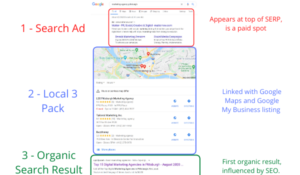Digital Marketing Building Blocks: The 3 That Have Been the Most Helpful For Me
Digital marketing is a dense and and complicated discipline. When done right, it can get your company leads, improve profits and drive brand awareness. Working as an intern this past summer has given me deeper insight into this world. So, I’m going to break down some of the building blocks that have been helpful on my own digital marketing journey.
My 3 Basic Digital Marketing Building Blocks
My digital marketing journey began 2 years ago with a class covering the basics of Google Ads and Analytics. Through practice outside of class and internships, I now feel confident working in SEO, analytics, and much of digital marketing. When thinking about all I’ve learned, I consider these great jumping off points for understanding digital marketing.
- SEO: what it is and how it leads to ROI
- All things Google: Ads, Analytics, Google My Business, etc
- Understanding a Google Search Results Page
When saying ‘digital marketing’, this means all the ways we can get a potential customer (who doesn’t know us) to a potential lead that is engaged and interested. These three efforts above are all ways we can try and get everyday people to become leads.
SEO
SEO (or Search Engine Optimization) is the discipline of optimizing our content for search visibility. In other words, things we do so Google will rank us on a search engine results page (SERP). These can be broken down into two broad categories: On site SEO and Off site SEO.
On site SEO: This is exactly what it sounds like: efforts made on your site to optimize content and enhance search visibility. This can include activities like blog writing about relevant topics people want to see.
Off site SEO: You can probably guess what this is! Off site SEO refers to the efforts off your website that enhance your organic search visibility. This includes work on your Google My Business listing, managing local business listings, and getting links from other destinations that point to your site.
How SEO leads to ROI: So why is SEO important? Well, it’s a discipline tailor made for driving ROI. ROI is a term used a lot in business. Put simply, ROI asks this question: is the work I’m doing going to provide the company a profit or a benefit? Or, are you getting a return (positive outcome) on your investment (your time and effort). By constantly making efforts to make the content on your site more attractive to both search engines and people, more potential leads and customers are seeing your site. That can lead to more site visits, more leads, and more sales!
With tons of applications to use and billions of users, Google is at the heart of digital marketing. Here are 3 key platforms to know from the digital giant.
Google Ads: Google Ads is where I began my digital marketing journey. This is the platform that lets you create/publish ads on Google, track their performance, work on keywords, and more.
Google Analytics: Google Ads and Analytics often go hand in hand for your marketing efforts. I began to understand Google Ads much more once I grasped Google Analytics alongside it. This application helps you measure and analyze your marketing efforts.
A great starting point for digital marketers is to gain your beginner certifications in Google Ads and Google Analytics. It’s completely free and has a guided course to teach you the specifics!
Google My Business
Remember when I mentioned the term ‘Off Site SEO’? Google My Business (GMB) is a key driver of Local SEO, which is a huge part of Off Site SEO. It’s especially important for businesses with a brick and mortar presence.
You’ve seen GMB results as that panel of information on the right side of a Google SERP with information like a business’ address, contact info, reviews, FAQs, and photos. The better optimized a Google My Business listing is, the more likely it is to pop up when users search. For example, a restaurant with a well optimized listing will be more likely to show up when someone searches “Restaurants near me”.
SERP
SERP stands for Search Engine Results Page. It seems like a lot at first, but it’s exactly what it sounds like! A page of results you receive when you type in something to the search bar of Google. Or, the page of results you get when typing in a query to a search engine (google). The easiest way to understand a SERP is just to look at one!

This is our SERP! By making a Google search, I am given this page, or Search Engine Results Page (SERP). When making the search query “Marketing Agency Pittsburgh” I am given these results, which can be broadly split into 3 categories. 1 – Ads, 2 – the Local 3 Pack, 3 – the Organic Search Result.
1 – Search Ad
The red box at the top of the page is our ad (specifically, a search ad). This means that company used Google Ads to pay for that spot on this SERP. This spot is not dependent on their SEO efforts, it is because they paid for that spot through keyword bidding and efforts on Google Ads! (Keyword bidding basically means how much you are willing to spend in Google Ads to rank for a certain keyword.)
2 – Local 3 Pack
The blue box at the center of the screen is called the local 3 pack. This involves local, or off site SEO (SEO efforts that take place off of our website). This local 3 pack is synched up with Google Maps. Meaning, it’s important companies are in the 3 pack when someone reaches a SERP. Reasons a company may appear here could be location to the searcher, reviews, ratings and more. Ads can also appear in the local 3 pack. Keep an eye out for those, it means they did not get there based on SEO efforts alone!
3 – Organic Search Result
The green box at the bottom of the screen is the Organic Search Result. Specifically, the first result for this query. This is where on site SEO efforts pay off. Organic results (results that are not an ad and are not paid for) is what on site SEO is working towards. Ranking well is very important for queries like this, because as you can see, there’s not much space on the screen! Ads and the local 3 pack take up a lot of real estate on a SERP, so doing well organically is very important.
This example is not what every SERP page looks like. Depending on what products you search/how you search, your query will really differ what comes up. Type in different queries and notice what appears on your SERP, every one is different!
Why It’s Important
Top results on a SERP are what we are constantly working towards. We are performing SEO efforts to rise to the top of the SERP organically, because that’s where our consumers are! Organically means we did not pay for that spot on the SERP. Our own efforts and the searcher’s query brought us there. So if the first results for your search for “ice cream” is a Ben & Jerry’s ad, they did not appear organically! They paid for that spot.
There’s always more to learn when it comes to digital marketing, but these are awesome jumping off points to get started. Interested in learning more? Whether you’re a newbie to marketing or an expert looking to have a discussion, contact us here and we are more than happy to chat.
Happy Marketing!





Leave a Reply
Want to join the discussion?Feel free to contribute!